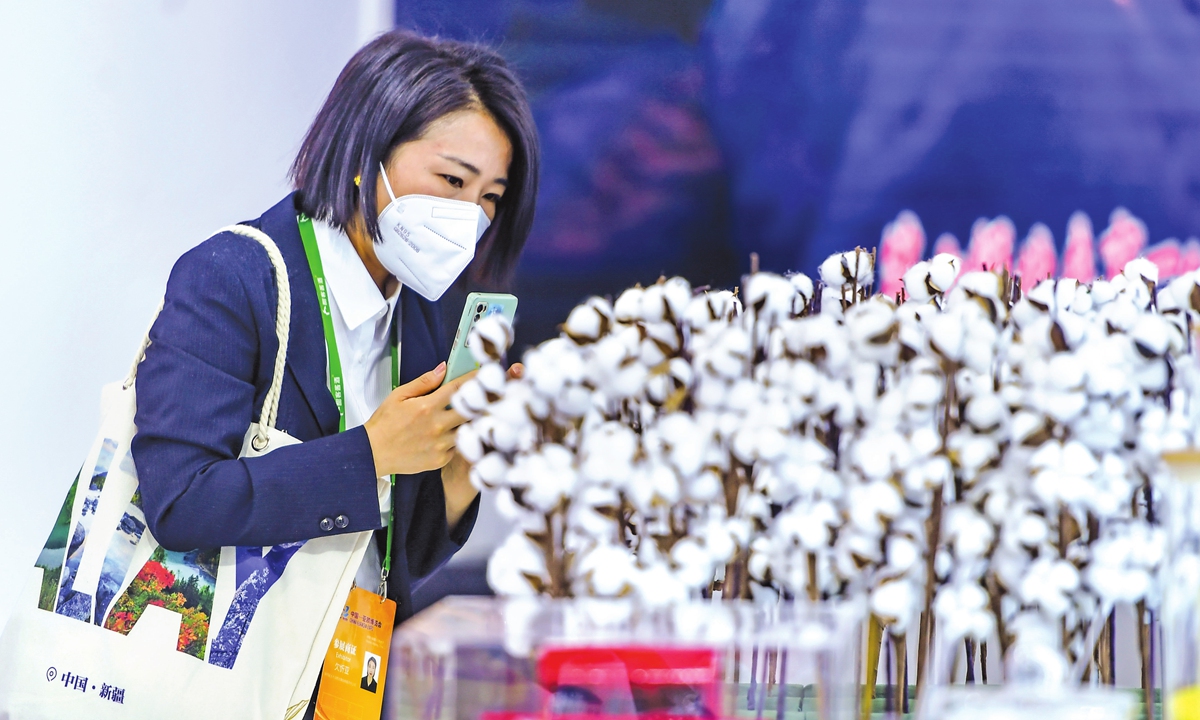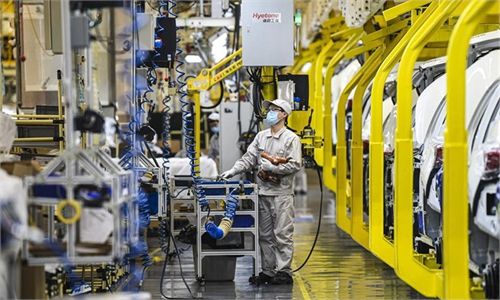Expo in Urumqi marked by growing cross-border investment, partnership between China and Central Asian countries
Expo in Urumqi marked by growing cross-border investment, partnership

A visitor takes photo of the white cotton balls picked from fields in Urumqi, Northwest China's Xinjiang Uygur Autonomous Region at the 7th China-Eurasia Expo on September 20, 2022. Photo: VCG
Banking on the cooperative spirit reinforced by meetings between heads of states of China and Central Asian countries, companies attending the 7th China-Eurasia Expo in Urumqi city say investment opportunities are mushrooming in Central Asia.
The expo, which concluded Thursday in Urumqi, Northwest China's Xinjiang region, saw investment contracts worth 1.17 trillion yuan ($165.6 billion) being inked, more than tripling the amount in 2018 and signaling the vast potential of Eurasia economic cooperation, Xinhua News Agency reported.
Agriculture and transportation, as the traditional focus of cooperation between China's Xinjiang region and Central Asia, continue to receive high attention and business executives at the expo noted that a new model of cooperation is reinventing the sectors and bringing forward new outcomes.
With the deepening of cooperation between China and Central Asian nations, many realize that the scope and scale of trade and investment between them will surge, experts say.
Enlarging Eurasia link
One such sector is overland transportation, which, despite being the backbone of trade between northwestern China's Xinjiang and neighboring countries, is continuing to receive impetus as new market demand is tapped.
Zhang Sixin, general manager of Xinjiang Zhonghuan Logistics Co, said one of his company's missions is to tackle the infrastructure bottleneck curbing the rising demand and that investment in the transportation sector still had a long way to grow.
In 2021, the freight truck depot at the China-Kazakhstan border can only handle 10 trucks per day due to strict anti-pandemic requirements, according to Zhang. "In 2022, the number has been ratcheted up to 362, and we are eyeing 800 in 2023," Zhang said.
Enhancing the road infrastructure involves the construction of road, bridges and truck depot at the border.
At the expo, Zhang's company inked 2.5 billion yuan deal to expand the depot at Alashankou road port, offering services from parking and accommodation to warehousing and switching.
"The feeling was that a race was going on in expanding depot capacity between us and our Kazak friends. Last year, it was the Kazakhstan side that being the bottleneck but they are busily expanding the capacity this year," Zhang said. "Next year, it would be the Chinese side to invest and expand the capacity. The demand is really big."
In the field of agriculture, Xinjiang-based companies are using the region's strength in technology to jointly develop new business with partners in Central Asia.
Xiao Guoying, an executive with Xinjiang Zhongtai (Group) Co, Xinjiang's newly minted Fortune Global 500 company in the business of chemicals, agriculture and logistics, told the Global Times that the expo demonstrated the strong willingness on cooperation from a wide number of foreign countries to seek the opportunity of common prosperity with China due to China's strong economy.
Attending an investment signing ceremony in which companies from China and Kazakhstan inked a wide range of contracts over the purchase of green energy equipment and agricultural products, Xiao said her company has sent special teams to explore business opportunities in Central Asian countries, Russia, Southeast Asia and Africa by visiting potential clients.
"We are actively exploring the possibilities of establishing an overseas warehousing facility and especially looking at potential opportunities along the routes of the planned China-Kyrgyzstan-Uzbekistan (CKU) railway and bring our products to more corners of the world."
Wang Bin, an executive with Xinjiang-based electric equipment manufacturing giant TBEA Co, also told the Global Times on Thursday that last week's top-level diplomatic exchanges between leaders of China and Central Asian countries bolstered the company confidence in Central Asian markets.
Local communities benefit
Zhang said the flow of goods also depends on the flow of information.
"The demand is there, but you have to put people, local people who know the market, to collect the business information to ramp up volume," Zhang said.
For the five Central Asian countries and other 16 countries in Europe, Zhang's company is hiring a team of around five employees for each country. These operators find orders for the company's 3,000-strong truck convoys, which deliver goods across the Eurasia landmass from factory gate to factory gate.
For Xinjiang Zhongtai (Group) Co, the company actively participated in the Belt and Road Initiative, bringing advanced agriculture to Tajikistan.
In the country's' Khatlon Province, Zhongtai invested 100 million yuan to build up an irrigation system, and 80 percent of the water is provided to local people for free. The project solved water demand for agricultural use and provided drinking water for 300,000 local residents.
As a result of this investment, more Tajiks are returning to their hometowns and learn advanced skill of cotton planting. They don't have to work far away from home and receive a boost in income, Xiao noted.
At Danghara, the company's investment made the largest, cotton-to-apparel textile industrial park in Central Asia. The park has 13,333 hectares of cotton field, with a capacity of 150,000 spindles as well as two ginning plants.
The project, which provided more than 2,000 local jobs, is a history-making event in Tajikistan, pushing the country's textile industry forward by about 30 years.
Experts said that even electromechanical equipment, apparel and shoes and agricultural products remain Xinjiang's main exports, area of cooperation in these field still has huge room to grow as the huge potential of Eurasia and that recent progress was only the tip of the iceberg.


